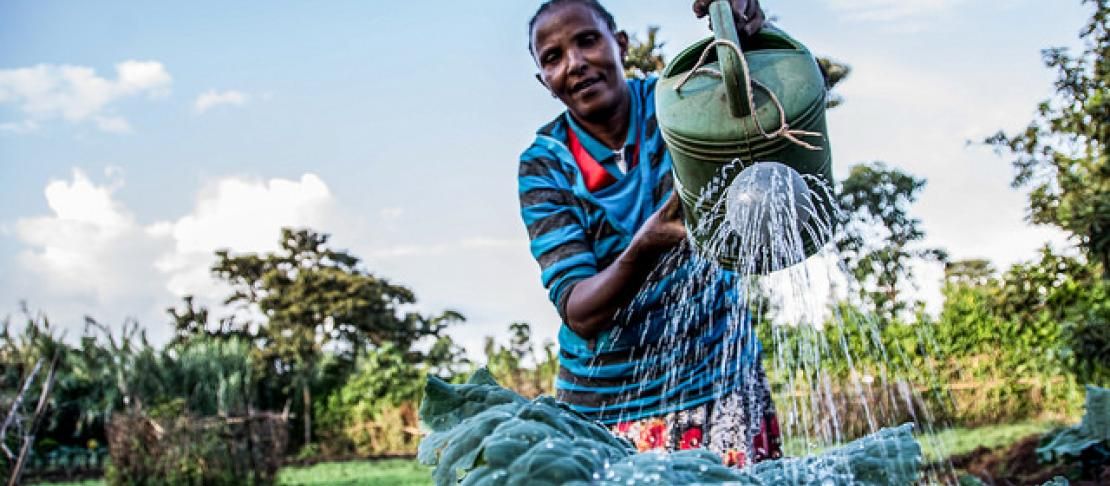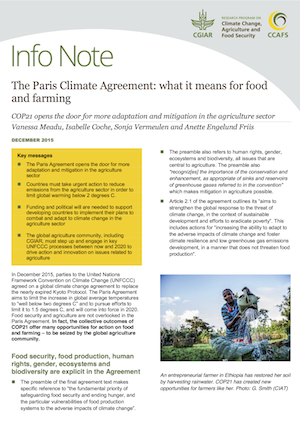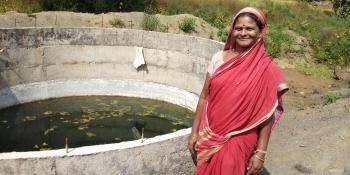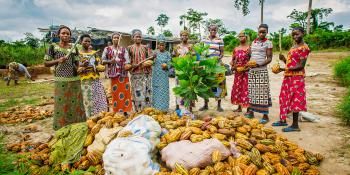Paris Climate Agreement unlocks opportunities for food and farming

COP21 opened the door for more adaptation and mitigation in the agriculture sector - will the agriculture community march in?
Read the full analysis

The Paris Climate Agreement: what it means for food and farming
After two weeks of negotiations, nearly 200 nations have finally agreed on a global climate change agreement to replace the nearly expired Kyoto Protocol. The Paris Agreement – which aims to limit the increase in global average temperatures to “well below two degrees C” and to pursue efforts to limit it to 1.5 degrees C – will come into force in 2020, and has already been hailed as historic and ambitious by many world leaders.
Though agriculture is not mentioned by name, food security, food production, human rights, gender, ecosystems and biodiversity are explicit in the Agreement
- The preamble of the Paris Agreement makes specific reference to “safeguarding food security and ending hunger, and the particular vulnerabilities of food production systems to the adverse impacts of climate change” and also refers to human rights, gender, ecosystems and biodiversity, all issues that are central to agriculture.
- Article 2.1 of the Agreement mentions the importance of protecting food production while reducing emissions.
The ambitious 1.5 degree C target offers some hope for farmers and food security
- The Paris Agreement aims to limit global temperatures “well below” two degrees C, and pursue a 1.5 degree target. As we’ve previously outlined, the debate between a 1.5 or two degree C target means different future scenarios for agriculture.
- A 1.5-degree temperature rise would produce fewer climate extremes than a two degree C temperature rise, which is good news for farmers in the tropics, who are on the frontline of heatwaves, droughts, floods and cyclones.
A 1.5 degree C target demands urgent mitigation in agriculture sector
- As we’ve noted elsewhere, a 1.5 degree C target will require even more mitigation effort from the agriculture sector than a two-degree target. But even with a two degree C target, by 2050 we will likely run out of viable options for reducing emissions from the industrial, transport and energy sectors.
- Reducing emissions from agriculture will be imperative as it will be impossible to stay within either a 1.5 or two degree C target if agriculture does not contribute to emissions reductions.
- The Paris Agreement notes that, on the whole, country commitments to reducing emissions will not limit global temperature rise to two degrees and that “much greater emission reduction efforts will be required”
Countries want to take action on adapting agriculture and reducing emissions from farming – but funds are not yet there
- Considerable finance is needed for agricultural adaptation and mitigation by Least Developed Countries (LDCs). Our analysis of the INDCs calculates at least USD 5 billion annually.
- The Paris Agreement commits developed countries to set a new collective financing goal of at least USD 100 billion per year, “taking into account the needs and priorities of developing countries” but does not include binding requirements on financial contributions by individual countries
Find out more about how to engage in SBSTA with our Toolkit to the UNFCCC Negotiations on Agriculture
Issues related to agriculture are being discussed in a slow-moving parallel process under the Subsidiary Body for Scientific and Technological Advice (SBSTA)
- Now is the time for countries and observers to prepare their submissions on agriculture to SBSTA for discussion at workshops scheduled for June 2016.
Critical next steps for the global agriculture community
There are some imminent challenges, now that the deal is done. Will countries take action quickly enough to limit global warming below 2-degrees? Will funding will be on hand to support developing countries to implement their plans to combat and adapt to climate change in the agriculture sector? And will there be enough political will to move away from ‘business as usual’?
The Paris Agreement opens the door to further work on agriculture before now and 2020, when the Agreement takes hold. This is the chance for the global agriculture community, including CGIAR, to step up and drive action: download our new info note to read our key recommendations for action.
CCAFS at COP21
Did you miss any of our events? A full rundown of COP21 events is available.
Further reading
Info note: The Paris Climate Agreement: what it means for food and farming by Vanessa Meadu, Isabelle Coche, Sonja Vermeulen, Anette Engelund Friis.
Info note: How countries plan to address agricultural adaptation and mitigation: An analysis of Intended Nationally Determined Contributions by Meryl Richards, Thilde B. Bruun, Bruce M. Campbell, Lucy E. Gregersen, Sophia Huyer, Victoria Kuntze, Simone T.N. Madsen, Mads B. Oldvig, Ioannis Vasileiou
Info note: Progress on agriculture in the UN climate talks: How COP21 can ensure a food-secure future by Merylyn Hedger, Bruce Campbell, George Wamukoya, James Kinyangi, Louis Verchot, Lini Wollenberg, Sonja Vermeulen, Peter Minang, Henry Neufeldt, Alain Vidal, Ana Maria Loboguerrero Rodriguez, Anette Engelund Friis, Alberto Millan
Toolkit: Guide to the UNFCCC Negotiations on Agriculture by Farming First, CTA and CCAFS
Opinion: Climate Change: Half a Degree Will Make a World of Difference for the Food We Eat by Bruce Campbell. Huffington Post, 9 December 2015.



